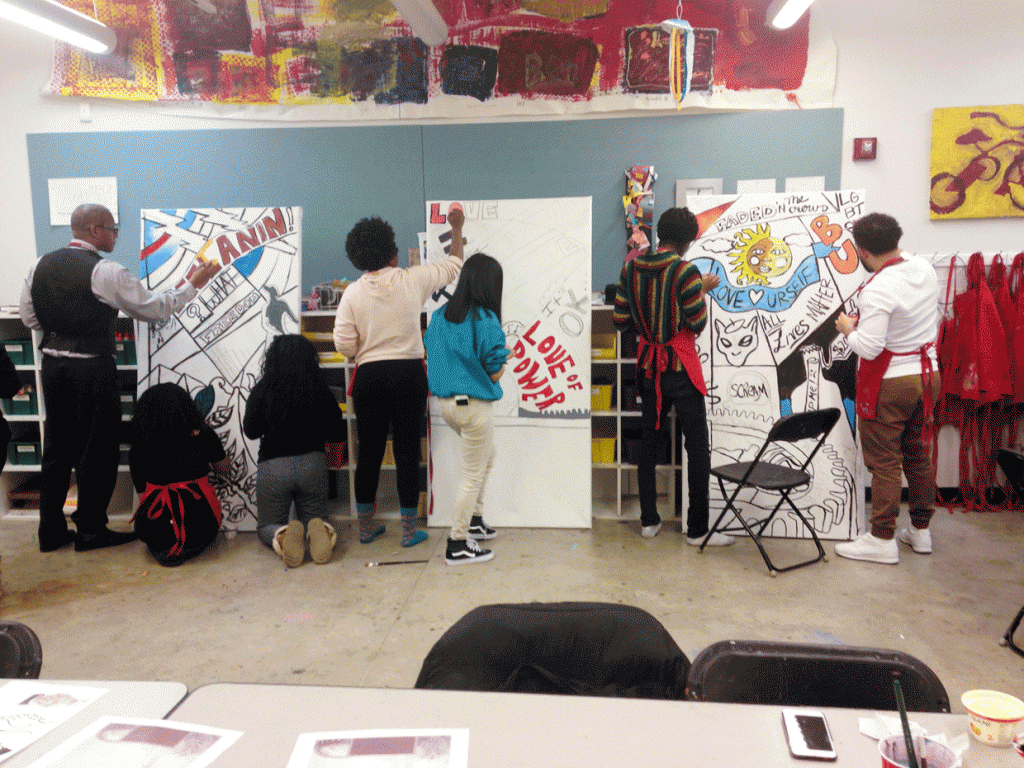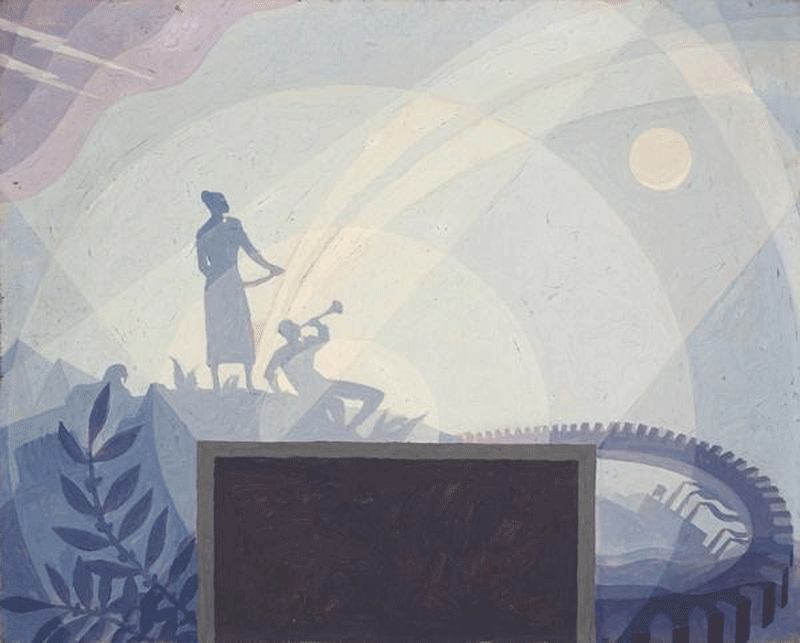 Unveiling of Student Mural Project at the Delaware Art Museum
Unveiling of Student Mural Project at the Delaware Art Museum
In honor of Black History Month, the Delaware Art Museum will unveil an Aaron Douglas-inspired mural created by local high school students. The February 4th unveiling ceremony is open to the press and public and will include a short presentation from 6:00 p.m. to 6:30 p.m. During the presentation, the students who created the mural and the arts educator and artist who ran the program, Chad Cortez Everett, will speak about the art making process. Light refreshments will be served.
The mural is part of the Museum’s Mural Arts Interpretation Project, a student-art initiative created last fall with the goal of exposing underserved students–those who have not taken part in an art class or had access to art education since middle school–to meaningful art education while raising public awareness of cultural diversity. The project includes eight high school students from William Penn and Dickinson high schools and was led by Everett.
The students’ mural is a large-scale painting inspired by Study for a Mural by Aaron Douglas (1899-1979), an African American illustrator and muralist and important Harlem Renaissance artist.Study for a Mural (c.1963)–currently on view in the Museum’s modern American Art gallery–was a mural design for the home of Dr. W.W. and Mrs. Grace Goens, a prominent African American family in Wilmington, Delaware. Douglas painted two murals for the Goens family and this study presents his design for the second mural for their Hockessin home in 1964.
Over the course of 10 weeks, Everett and the students met to discuss how they can preserve the spirit of Douglas’ work while transforming it to reflect themselves and today’s society. After learning about Douglas and the Harlem Renaissance from Delaware Art Museum Curator of American Art Heather Campbell Coyle, the students spent a week discussing what their thoughts were about the world they live in and how that might be different than the world during Douglas’ time. The students decided to incorporate text from their discussions into the design and learned how to transfer an image to large canvas panels.
The words the students discussed and chose were born out of the original themes of the piece: African American history, cultural significance, and societal progress. As the students planned the mural design, they came up with images and symbols that serve as important markers of their own personal histories. After a discussion about monochromatic color (as Douglas typically painted) the students chose to use local color and edit as they went, preserving a homage to Douglas’ color scheme in the bottom right corner of the piece. The three-panel piece, which will be named duringThursday’s presentation, will be on display on the Museum’s lower level during the month of February.
The Delaware Art Museum is open late every Thursday evening from 4:00 p.m. – 8:00 p.m. with free general admission. Special events and programs for all ages are offered on select nights throughout the year. For a full schedule of events and programs, visit delart.org.
Sponsors
This program was made possible by an anonymous donor and a grant from the Delaware Division of the Arts, a state agency dedicated to nurturing and supporting the arts in Delaware, in partnership with the National Endowment for the Arts.
About the Delaware Art Museum
Founded in 1912, the Delaware Art Museum is best known for its large collection of works by Wilmington native Howard Pyle and fellow American illustrators, a major collection of British Pre-Raphaelite art, and urban landscapes by John Sloan and his circle. Visitors can also enjoy the outdoor Copeland Sculpture Garden and a number of special exhibitions throughout the year.
The Delaware Art Museum is located at 2301 Kentmere Parkway, Wilmington, DE 19806. Open Wednesday: 10:00 a.m. – 4:00 p.m., Thursday: 10:00 a.m. – 8:00 p.m., and Friday –Sunday: 10:00 a.m. – 4:00 p.m. Monday and Tuesday: Closed. Admission fees are charged as follows: Adults (19-59) $12, Seniors (60+) $10, Students (with valid ID) $6, Youth (7-18) $6, and Children (6 and under) free. Admission fees are waived Thursdays after 4:00 p.m. and Sundays thanks to support from generous individuals. For more information, call 302-571-9590 or 866-232-3714 (toll free), or visit the website at delart.org.
Top to bottom: Photography by Museum staff. | Study for a Mural in the Home of Dr. W.W. and Mrs. Grace Goens in Hockessin, Delaware, c.1963. Aaron Douglas (1899-1979). Oil on canvas board, 15 15/16 x 20 inches. Acquired through the partial gift of Alberta Price Fitzgerald, and Wilson, Deborah, and Lauren Copeland in honor of Walter and Grace Price Goens; Acquisition Fund; a generous contribution from the City of Wilmington; contributions from The Judith Rothschild Foundation; Donald J. Puglisi; Rodman Ward, Jr.; Peggy H. Woolard; H. F. and Marguerite Lenfest; Paula J. Malone; Lynn Herrick Sharp; Robert and Mike Abel; P. Coleman Townsend; Danielle Rice and Jeffrey Berger; and other contributors, 2008. © Artist’s Estate.
Thank you to the Delaware Art Museum for the content of this post.
Like Delaware Art Museum on facebook
Like DoNArTNeWs Philadelphia Art News Blog on facebook
Follow the new DoNArTNeWs.com
Follow DoN on Twitter @DoNNieBeat58
DoNArTNeWs on Tumblr
@donniebeat on Instagram
Affiliate Marketing [disclosure page] Shop on-line and help support DoNArTNeWs
Donate via safe and secure PayPal in the sidebar.



